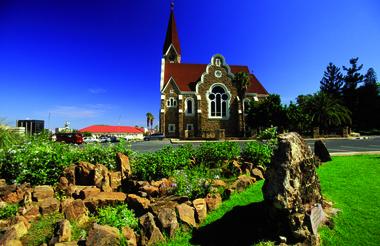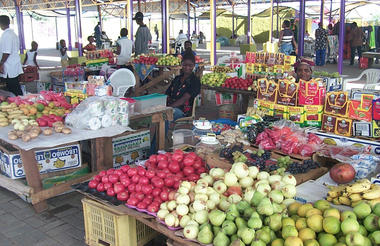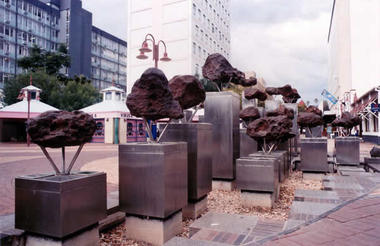Upon your arrival at Windhoek International Airport your driver will meet you and transfer you to Habitas Namibia, where the captivating landscapes of the country will unfold.
Upon arrival at Habitas Namibia, our attentive staff will ensure a seamless check-in for your comfort. Feel free to enjoy the property
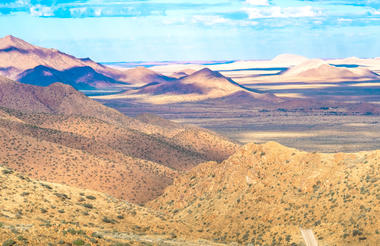
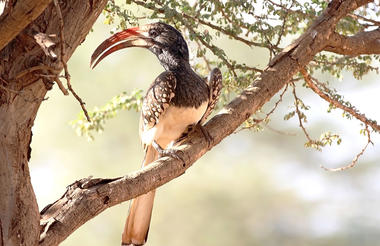
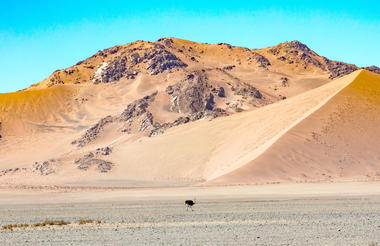
While it's optional to exclude this day from the itinerary, we strongly recommend keeping it. The substantial distances between destinations make it beneficial, ensuring you start your first official day early and fully rejuvenated. Your overall experience will be greatly enhanced by taking advantage of this additional day for rest and preparation.
- 1 Night accommodation
- Breakfast
- Transfer from Hosea Kutako International Airport to Habitas Namibia
Windhoek to Sossusvlei Lodge
Arrival and downtime at Sossusvlei Lodge
Dinner at Sossusvlei Lodge
As today is a lengthy drive from Windhoek to the Namib Desert.
The relatively flat landscape starts to give way to a more mountainous terrain as we get closer to the Namib Naukluft National park. We transit the captivating Tsaris mountain range. The Naukluft Park is one of the largest parks in Africa and the world at over 49,000km² (19,000sq miles), a little larger than Switzerland to put things into better perspective. The park is home to various species of wildlife, but more specially, the Hartmann Mountain Zebra which roam freely through the vast plains and mountains of this area. The Namib Naukluft Park also contains some of the most iconic attractions of the country, like the towering sand dunes of Sossusvlei.
Other attractions include the desert adapted vegetation of the area, like the Succulent Karoo, Camel-thorn Acacia, Lichens and many more. We reach our lovely lodge in the later afternoon hours, but with enough time to relax and recover from the lengthy drive. A wonderful sunset and dinner is something to look forward to this evening.



The dunes are best visited in the morning or later afternoon. At this time, the colour is more vibrant, the heat is less oppressive, and the crowds are diminished. At times, you’ll feel like the dunes are all yours to explore, so make the most of it. Hike (or try) to the top of one and admire the Mars-like landscape from above - it’s incredible.
Probably the most famous and photographed dune in Sossusvlei, Dune 45 is easily accessible; it lies 45km from Sesriem, just off the paved road.
Elim dune is located 5km inside the park gate and is an easily accessible option. It’s partially covered in vegetation, making it more distinct to other dunes in the area.
Like most great attractions around the world, it’s possible to go ballooning over the dunes of Sossusvlei. Flights depart before sunrise, where you’ll be treated to an epic live show of mother natures beauty.
- 2 Nights accommodation
- Dinner & Breakfast
- Sossusvlei National Park entrance and park fees
- Deadvlei excursion
- Sesriem Canyon excursion
- Bottled Still Water
- Transfer from Habitas Namibia to Sossusvlei Lodge
Sesriem to Deadvlei
Deadvlei excursion
Sesriem Canyon excursion
Dinner at Sossusvlei Lodge
A pre-dawn start is a must this morning in order to appreciate the wonders that this area has on offer. The morning will start with an excursion into the towering dunes of Sossusvlei.
Sossusvlei is the very end of the Tsauchab River, approximately 55km from the Atlantic Ocean, which on rare occasions turns into a true water filled oasis after heavy rainfall. This phenomena has not been evident for the last few years, as this area is predominantly bone-dry throughout the year averaging around 20mm of rainfall per annum.
We return to our lodge just before noon in order to enjoy some lunch, and enjoy some pool time. Our late afternoon activity would see us visit the Sesriem Canyon, before enjoying another scrumptious dinner at our lodge.



We enter Sossusvlei at sunrise in the morning and remember to take plenty of water, sun cream, a hat, walking shoes, camera batteries and film/memory. Explore some of the world's highest dunes and a sheltered pan with petrified trees that are hundreds of years old; climb the dunes and look out over at the sandsea. Private reserves in the area reveal fascinating flora, fauna and ancient desert landscapes.
Other attractions in close proximity to Sossusvlei include Sesriem Canyon, Dune 45, Hiddenvlei, Big Daddy and Deadvlei. All of these attractions can be accessed from the road that takes you to Sossusvlei, and are all well worth a visit. In a number of areas surrounding Sossuvlei look out for the petrified dunes.
The Sossusvlei area offers visitors some of the picturesque and indescribable landscapes in the world, with unbelievable colour contrasts at sunrise and after sunset along with amazing photographic opportunities. Here we will also look at the abundance of small life, which baffles the mind as to how the numerous creatures can survive in this harsh and unforgiving Namib desert.
Hot Air Ballooning & Breakfast
Sossusvlei Lodge to Swakopmund
Arrival and Downtime in Swakopmund
Swakopmund Museum
Swakopmund Walking Tour
Dinner in Swakopmund
We leave the Sesriem area early enough to enjoy a cool scenic drive to the coastal town of Swakopmund along the mighty Atlantic Ocean as we get closer. The Tropic of Capricorn, which forms the circle of the latitude that contains the subsolar point on the December solstice is on our route, and here we will stop for a picture or two. We also transit via the Gaub and Kuiseb Mountain passes which warrant short stops, as the geology around these areas is extraordinary.
Upon our arrival in Swakopmund, and after a brief lunch we embark on a short afternoon walking tour to see the town’s historical monuments, and acquaint ourselves with a few optional activities for the next day which are on offer, but we look forward to the Dolphin tour scheduled for the following day in Walvis Bay, Namibia’s port capital. Swakopmund is situated amidst dunes and desert close to the mouth of the Swakop River, and during the colonial period Swakopmund was an important hub, although the conditions for a deep-sea port were not favourable here. The coastal waters were far too shallow, a sheltered lagoon was missing and the surf was much too strong.
We have a relaxed late afternoon, before dinner at a local seaside restaurant.



Visit; restaurants, shops and attractions in Swakopmund; spend some time making the most of the cool air and refreshing sea. Among the many activities on offer here, we recommend a scenic flight over Skeleton Coast; an informative living desert tour, sandwich harbour tour, and other activities like the quad-biking and sandboarding in the dunes, and skydiving for the adventurers.
- 2 Nights accommodation
- Hot Air Ballooning
- Breakfast
- Swakopmund Walking Tour
- Bottled Still Water
- Transfer from Sossusvlei Lodge to Swakopmund Hotel & Entertainment Centre
Optional Activities on offer in Swakopmund & Walvis Bay
Dinner in Swakopmund
The town of Swakopmund is known for its variety of activities that it offers to travellers and is often referred to as the adventure capital of Namibia.
You have the option of conducting a Dolphin Cruise activity which affords our guests a chance to learn about the marine life on the Namibian Atlantic coast and the possibility of seeing the various species of dolphin we have in Namibia, as well as whales, seals, pelicans and much more. Upon your return from Walvis Bay around noon, your afternoon will be a relaxed one. Our guests will have a chance to visit some curio shops, the beach, Swakopmund Aquarium, and just wonder the lively markets of this unique city.
Dinner this night will be without your guide at another lovely seaside restaurant booked for you.
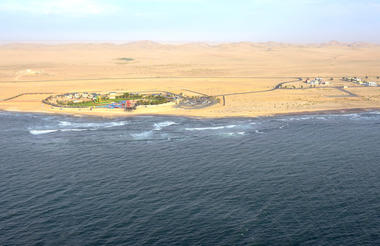
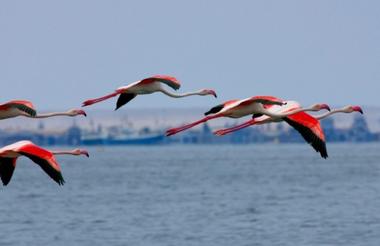
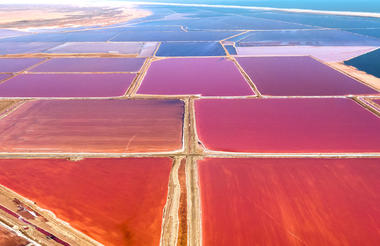
You will have a chance to visit some curio shops, the Swakopmund museum, Kristall Galerie or just wonder the lively markets of this unique city. Dinner this night will be at another lovely seaside restaurant booked for you.
Many tourists associate Namibia with the desert so visiting the spectacular red-sand dunes in the Namib Desert is a must-do thing for anybody visiting Swakopmund. The unique scenery and unreal beauty of the desert. It was definitely one of the highlights of any Namibian trip.
- Breakfast and a relaxed morning in Swakopmund
- Transfer and Arrival in Spitzkoppe
- Lunch at Spitzkoppen Lodge
- Optiona Activities
- Dinner at Spitzkoppen Lodge
The Spitzkoppe is one of the most photographed mountain motifs of Namibia. This inselberg surmounts its surrounding by 700 metres (2,296ft) with an overall height of 1728 m (5,669ft) above sea level. Due to its distinctive form, which can be spotted from a great distance the Spitzkoppe is often called the “Matterhorn” of Namibia. Actually the Spitzkoppe consists of two separate mountains: The large Spitzkoppe, which is 1728 m (5,669ft) high and the small Spitzkoppe, which has a height of 1584 metres (5,197ft). Further west we also find the so-called Pontok Mountains.
For hikers and mountaineers the Spitzkoppe is a paradise. Beginners can practice nicely here and for professionals the ascent of the peak is a real challenge as it is difficult. The first ascent of the challenging west side was in 1946 and up to today only 600 roped parties have succeeded to reach the peak.
Located at the foot of the sprawling granite formation one will find a beautifully maintained campsite where we'll pitch our tents and enjoy breathtaking views that surround us in all directions.
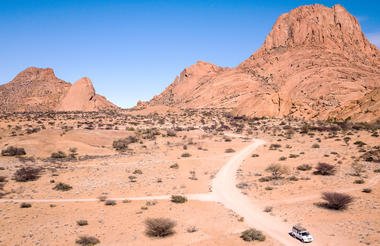
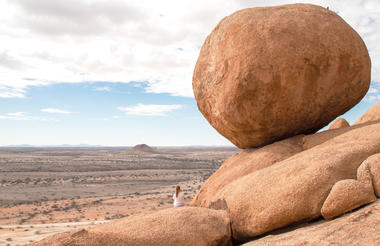
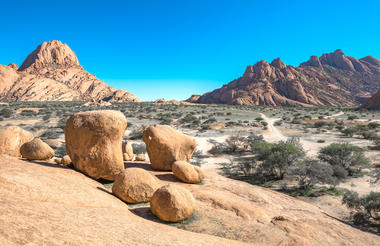
The best thing to do at Spitzkoppe though, is nothing at all. Spend some time sitting in a chair just staring at the amazing views around you, and enjoy a kind of solitude and quiet very few places in the world still offer.
Spitzkoppe are best seen when camping overnight, although lodging here is just as lovely, as you'll have ample opportunity to capture the contrasting light and shadowy patterns as the sun rises and sets, visitors on more of a tight time schedule should try to budget at least 4 hours in the area. The Spitzkoppe mountain range's granite is dated at more than 700 million years old.
Take plenty of sunscreen, a sunhat and wear loose clothing that offers protection from the sun. Also, wear closed footwear, not flip-flops or sandals. The sand can become quite hot and may burn your feet.
Archaeological Sites
Guided Walks | Drives | Cycling Tours
Restaurant
- 1 Night accommodation
- Dinner & Breakfast
- Bottled Still Water
- Transfer from Swakopmund Hotel & Entertainment Centre to Spitzkoppen Lodge
Swakopmund to Palmwag Lodge
Arrival and Downtime at Palmwag Lodge
Dinner in Palmwag Lodge
We take off from the Spitzkoppe early this morning as we do have a lengthy drive that take us pass the small former mining town of Uis on route to the Palmwag rhino concession. On our way, we pass the Brandberg mountain, known to be the highest mountain in Namibia at over 2,500m (over 8,400ft) above sea level.
We will also transit through the Twyfelfontein area of Damaraland, which is home to a world heritage site and an optional stopover for our guests who are interested in seeing the iconic rock engravings made by the San people, of which some date back to over 6000 years.
Our late afternoon arrival at the Palmwag area warrants a cold beverage at our beautiful lodge! The Palmwag concession also pays homage to the Desert-Adapted Elephants of Namibia. We will have dinner at our lodge and attend to other organisational matters.



The Palmwag concession is an area covering over 400,000 hectares (988,400 Acres) of conservation land, and is home to lions, leopards, cheetahs, zebra, springbok, desert-adapted elephants and much more. The reserve is specially known for providing habitat for the largest population of south-western black rhinos in Africa, under the protection of the organization known as the Save the Rhino Trust. Our guests have the optional half day rhino tracking activity, or they can conduct a game drive and other activities on offer here.
- 2 Nights accommodation
- Dinner & Breakfast
- Bottled Still Water
- Transfer from Spitzkoppen Lodge to Palmwag Lodge Gondwana Collection Namibia
Palmwag Lodge
Optional Game Drive and Rhino Tracking on Foot Activity on offer
Dinner at Palmwag Lodge
Adjacent Conservancies to the Palmwag Concession and communities are supportive of the Concession and are likely to continue to be so, provided that the balance of costs and benefits flowing from the use of the area is maintained and improved. There are also suites of complex rela- tionships between Conservancy Committees, the Damara Traditional Authority, local communities, NGOs active in the region, com- mercial operators and others that must be reconciled to best insure the region’s social and ecological viability.

The Palmwag concession area is home to the largest predator population outside the Etosha National Park, with over 100 lions, cheetah, leopard, brown and spotted hyena. Bird life is prolific and diverse with most of Namibia's endemic species occurring here.
The Palmwag Concession is one of the largest private concession areas in the world and Palmwag Lodge, in collaboration with the Ministry of Environment and Tourism, Save the Rhino Trust and neighbouring Conservancies, promotes responsible tourism so that conservation as well as the residents of the area can benefit.
Palmwag to Etosha Safari Lodge
Himba Cultural Excursion
Arrival and Downtime at Etosha Safari Lodge
Dinner at Etosha Safari Lodge
This day would require yet another early departure, as we are anxious to reach the lovely Etosha Safari Lodge, on the bounds of the famous Etosha National Park. One of Namibia’s most exceptional adventures is to visit the Etosha National Park.
Our journey today takes us to this great game sanctuary through some of the lands belonging to the iconic Himba tribe, and plan to stop by for a cultural interaction before continuing our journey to our lodge. We arrive at our accommodation in the late afternoon hours. A beautiful African sunset and great dinner is on the cards for this evening from our beautiful lodge.



SOME PACKING ESSENTIALS FOR ETOSHA NATIONAL PARK:
Headtorch – Required for your overnight camping in Etosha, you will require a headlamp or portable lamp of some sort. Consider a good LED option.
Good Camera – Etosha is one of those ultimate bucket list destinations in Africa and travelling here with a good camera will help you preserve the memories. A light, compact and robust camera is recommended.
Sun Hat, Sunscreen & Sunglasses – Namibia is hot all year round, with some crazy strong UV rays, so making sure you pack a sunhat, sunscreen & sunglasses for adequate protection is key.
Insect Repellent – Malaria is a low risk in Etosha National Park, however, be sure to cover up at night and use at least a 30% DEET repellent.
Sarong – Whether it’s for covering your shoulders from the sun, using as a sheet when camping or as a towel after your shower, a sarong is a great multi-purpose travel item to bring here.
A beautiful African sunset in the bush is always a wonderful sight. Etosha has two seasons. The wet season runs from November to May and the dry season from June to October. In the wet season the land is green and lush, vegetation thick and roads muddy. The animals spread out over the wide plains and disappear into the bushy shrub. Some roads are closed and driving becomes trickier.
The dry season forces animals to congregate around waterholes. As zebra, springbok and impala gather to cool off and quench their thirst, opportunistic lions and cheetahs take advantage of knowing where their prey is going to be. This creates the perfect environment for great game viewing.
The vast majority of the driving in Etosha is on gravel tracks. Most are relatively straightforward and easy to drive on but some can become rutted, making journeys a bit slower.
- 2 Nights accommodation
- Dinner & Breakfast
- Himba Cultural excursion
- Bottled Still Water
- Game Drive in safari vehicle
- Transfer from Palmwag Lodge Gondwana Collection Namibia to Etosha Safari Lodge Gondwana Collection Namibia
Full Day Game Drive in Etosha National Park
Dinner at Etosha Safari Lodge
You'll start early this morning with a safari guide for your game drive to look for your favourite animals today, as you'll be on route to see and learn about as much of the free roaming wildlife in this area as you can. The Etosha National Park is famous for African elephant, lion, leopard, hyena, rhino, and other antelope sightings, offering a very pleasant experience, especially to first timers in the part. The waterholes at clearly marked and the maps of the park are very clear. Today's route will take you throughout most of the southern and western parts of the Etosha National Park.
In the dry season, Etosha National Park has excellent viewing in the heat of the day – a fairly unique phenomenon thanks to the abundance of waterholes. Vast herds of zebra, springbok, impala and oryx are joined by ostriches, giraffe and elephants trying to cool down and quench their thirst.
You do not get back to our accommodation until late in the afternoon, and just in time for another delicious dinner.



The Etosha National Park is famous for African elephant, lion, leopard, hyena, rhino, and other antelope sightings, offering a very pleasant experience, especially to first timers in the part. The waterholes at clearly marked and the maps of the park are very clear and simple to follow.
WHAT TO EXPECT ON A GAME DRIVE:
Every game drive is different – which keeps things exciting – but the format of a game drive is likely to be quite similar, wherever you are:
The time of day will usually be early mornings, late afternoon or at night – the coolest times of the day when most animals are more active.
With the length and distance will vary, game drives last around 3 to 4 hours, and will include a break.
With luck you’ll see a mix of different wildlife sightings, with stops to take in and photograph each animal
type.
You should get plenty of conversation with your tour guide to learn about the animals you see, plus lots of
other related info about the habitat, plants, birds, animal tracking, and if you’re lucky, the occasional
amazing animal story or two.
A break where you can get out of the vehicle and have a drink and a snack – usually somewhere with a great
view of wildlife and/or the bush. On morning drives you’ll likely have a hot drink, and afternoon drives warrant something a little colder. Unbeatable!
Game viewing in a rented VW Kombi
Explore the Etosha National Park
Dinner at Onguma Bush Camp
Our guide will take you through the Etosha National Park for yet another full day in order to give you more time to discover the north-eastern end of this vast park maximizing your chances of seeing more wildlife. Etosha Pan lookout point is a great stopover while enjoying our game drive, to see the vastness of the great white open space.
This park, which was first proclaimed a national park in 1907, but has significantly decreased in size since then. We continue to search for more wildlife while seeing a variety of different bird species.
After a full day of game driving in the park, we will have our final evening in the area just outside the eastern gate of the park, in the Onguma Private Game Reserve.


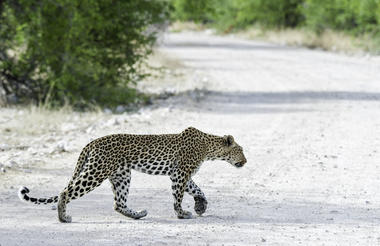
Onguma Bush Camp is within the Onguma Game Reserve. It borders on the eastern side of the Etosha National Park at Fisher’s Pan. The lodge’s central area overlooks an active waterhole where guests can view the game coming for a drink from the comfort of the lounge or swimming pool.
Of the 18 Onguma Bush Camp rooms, seven can accommodate families. This is the only Camp on Onguma Game Reserve with a fence and safe for a family safari. Here the children can explore in safety.
The Camp can arrange game drives in the Onguma Game Reserve and the Etosha National Park. Being a private game reserve, night drives and interpretive bush walks are additional activities.
- 1 Nights accommodation
- Dinner & Breakfast
- Bottled Still Water
- Transfer from Etosha Safari Lodge Gondwana Collection Namibia to Onguma Bush Camp
- Onguma to Okonjima Game Reserve
- AfriCat Foundation Day Centre Activity in Okonjima Game Reserve
- Dinner at Okonjima Lodge
We are traveling on the main road known as the B1 to the Okonjima Game Reserve, the home of the AfriCat Foundation, responsible for the rehabilitation of endangered large cats. We plan leave quite early this morning from the Onguma Game Reserve to arrive in time for an afternoon drive to see the cheetah and learn about these large cats at the AfriCat Foundation, and why they are indeed special to Namibia.
Our wonderful evening at this magical place will definitely leave our travelers with food for thought concerning the conservation work that these very extraordinary man and woman do here. We’ll enjoy our last dinner of this splendid tour together at the Okonjima Game Reserve.


Going back to the 1890’s and colonial South West Africa, Okonjima was used by the German military. Due to its relative high altitude, in the area, it was apparently free of the African Horse Sickness and therefore it was a good place to rest their horses. From the early 1920s Okonjima was used as a cattle farm and in 1970 Val and Rose Hanssen bought the farm, to breed and farm Brahman and Jersey cattle. Throughout the time that cattle were kept on the farm, loses of stock to predators, particularly leopards, caused a strain on the finances.
Okonjima’s relationship with Namibia’s big cats did not start too favourably, as livestock losses to predators resulted in them being actively persecuted. However, herein developed an interest to further understand the habits and behaviour of Namibia’s big cats, particularly leopards.
The tourism element to Okonjima had humble beginnings: it started in 1986 as an overnight stop for travellers between Etosha and Windhoek. From here it grew, they began to offer bird watching experiences, trails demonstrating skills of the Bushman and baited leopard viewing. They also raised a cheetah cub called Chinga, discovered in a cage at an auction, which would appear on the lawn at afternoon tea, and allow visitors to stroke it. The farm was very well run by the Hanssen family, and gradually word of Okonjima’s carnivores, and their work with them, began to spread. By 1992 Okonjima was a ‘highlight’ on any visitor’s trip around Namibia.
- 1 Night accommodation
- Dinner & Breakfast
- AfriCat Foundation Day Centre Activity in Okonjima Game Reserve
- Bottled Still Water
- Transfer from Onguma Bush Camp to Okonjima Plains Camp
Transfer from Okonjima to Okahandja
Okahandja Craft Market
Transfer from Okahandja to Windhoek
Today we will head to the airport, but this journey warrants a short stop in Okahandja. We’ve also come to the end of our safari as we continue south heading on the B1 road to the capital city of Windhoek, but transiting via Okahandja, and here we will take time to stop as this town is home to Namibia’s largest wood carving and craft market.



There are approximately 153 stalls in which vendors sell woodcarvings and other crafts in the two woodcarvers markets in Okahandja. The primary audience for these products is the tourists who must pass through the centrally-located town on their way to the popular northern and coastal destinations of Namibia.
Though no statistics are available for Okahandja specifically, national handicraft sales grossed N$8 million in 1991, and by 1996 reached N$17 million (Suich, 2002). The woodcarving trade historically comes from the Rundu and Caprivi regions of northern Namibia and most of the current craftspeople and products are still from these regions.
- 1 Night accommodation
- Breakfast
- Bottled Still Water
- Transfer from Okonjima Plains Camp to Habitas Namibia
- Transfer from Habitas Namibia to Hosea Kutako International Airport
- Tour of the Windhoek City & the Katutura Township
Lunch at Windhoek Craft Center Café
Transfer from Windhoek to Hosea Kutako International Airport
We provide you with a fully comprehensive two (2) hour tour which will start at the iconic Christuskirche in central Windhoek, and thereafter a short drive to the Bahnhof (old train station) is on the cards. We will also get an opportunity to drive down Independence avenue, which will allow you to see some of the city's old architecture. We will then make our way to the Old location cemetery as well as the township of Katutura, including a short stop at informal settlements, and a visit to the Penduka Women's centre.
This tour is a two (2) hour excursion but can take longer based on the number of questions, discussions and interactions with local groups.
There are lots of attractive green areas in the centre of Windhoek flanked by both modern buildings and fine German-colonial architecture. This city in Namibia is clean and orderly and the pace of life is busy but not overwhelming.
Historically known as a residential area for racial segregation during apartheid, Katutura symbolizes Namibia’s dark past (and even in some way present). While the city has left that chapter more or less behind, Katutura became the backbone of Windhoek.
